Through a haze of cloud, milky sunshine
washes the plains of the high Thames. It is an early October
morning, and the reason it is early is that from here on, out the back doors
of Oxford, the riverlands grow so remote that getting in and out becomes a
four- or five-stage operation, of almost as many hours, on increasingly patchy
public transport.
 |
| The ancient common of Port Meadow, stretching far up the west flank of Oxford. |
 |
| More cows graze by the river close to the northernmost point in its course. If you like cows you’re in the right place with this one. |
Gone are the towns and cities, the castles
and palaces, the towers of exclusion which lord over the middle Thames. Here there
is green as far as the eye can see, with only a smattering of small craft – tugs,
canoes, and the iconic narrowboats – puttering from lock to lock. This expedition,
having shoved through the English capital with its industrial relics, political
struggles and crowded illusions of modernity, then through the long parade of past
and present privilege-nests that hold the middle river, has at last broken out
to the high countryside, the remnants of the English bush, where the infant
river emerges from its cradle.
Peace at last then? Not quite. The
picture-postcard daydream of the upper Thames, in which it trickles serene
through grassy meadows and hamlets of beige Cotswold stone, belies a volatile
flow loaded with pent-up grievance. Concertinaed through bunched-up meanders
and straining in the fetters of its locks, the young river here is as liable as
any reach downstream to drown these low-lying plains in remorseless floods. And
as the water, so too the humans who have written their stories in it – for even
out here, stories of strife and struggle whisper from the reeds.
 |
| The ruins of the Godstow nunnery, on the outskirts of Oxford, is one of that city’s more mythically-charged installations. |
With the end in sight, it’s time to
step this expedition up a gear. The remaining sections, starting with this one,
are all twenty-kilometre hard slogs over open country. Anyone thinking of tackling
this for themselves should plan with full respect for weather and seasonal
conditions, in particular rainfall, flooding, and hours of daylight, as well as
preparing good footwear, sensible clothing, and well-organised travel and/or
local accommodation arrangements. Sufficient food and drink, especially water,
are vital; there are occasional pubs on or near the river, but also long
stretches in between with absolutely nothing.
As we shall see, you’ll also find
plenty of large animals in these parts. Be nice to them. Brexit wasn’t their
fault.
 |
| Upstream from Osney Bridge in west Oxford: the upper limit for large watercraft and effective gateway to the Upper Thames. |
Start: Osney Bridge (nearest station: Oxford)
End: Newbridge (no settlement, just a
bridge with a pub at each end; about five buses a day stop by the Rose
Revived pub on a Witney-Abingdon route)
Length: 21.7km/13.5miles
Location: Oxfordshire – City of
Oxford, Vale of White Horse, West Oxfordshire
Topics: Port Meadow, Godstow,
miles and miles of cow meadows and sheep meadows (Wytham Foothills, Farmoor
Reservoir, Bablock Hythe and Northmoor Meadows), Newbridge and the River
Windrush
Port Meadow
The river keeps its distance from central
Oxford, but its course
down the western flank of the university city is nonetheless close to its heart,
both in the high imagination of its myths and literature and more practically
in its daily jogs and strolls. More bucolic than the southward reaches and not
so integrated into its suburbs and its rowing, these northward banks draw
plenty of locals and their dogs out for morning exercise.
 |
| A reminder of the branching maze of channels into which the river splits around Oxford. This one wasn’t even the main flow, having been cut out by the monks of Osney Abbey to power their mills. The cut under the footbridge at right (east) links to the Castle Mill Stream and the start of the surviving part of the Oxford Canal, which runs all the way up to Warwick Province. To the left (west) the river’s old main course – now the Bulstake Stream – heads off down a weir-controlled open-air swimming pool that was closed in the 1990s. The water level gauge is a reminder that these flows are at times far more dangerous than they look here. |
 |
| The link to the Castle Mill Stream is known locally as the Sheepwash Channel, another echo perhaps of the Oxen-ford’s rustic origins. |
The towpath then crosses to a sliver
of an island barely three or four metres in width – essentially a raised track,
between the river to the west and the tiny Fiddler’s Stream to the east.
This Fiddler’s Island might look a charming place for a stroll, but its
severe vulnerability to flooding is obvious immediately.
 |
| Pretty, isn’t it? But signs warn that deaths have occurred during floods here and strongly advise people not to attempt to walk this path when it’s inundated. |
 |
| The Fiddler’s Stream is clogged with duckweed, making it popular with hungry waterfowl. |
 |
| Evidence of rather ferocious tree management across to the west. |
 |
| Your boat needs a low profile like this to make it up here past Osney Bridge. |
The island ends at a large boatyard,
right where the river and Castle Mill Stream first diverge. Here too is the
bottom corner of the vast Port Meadow, a 400-acre expanse of common
grazing land.
 |
| Here too are flashes of the otherworlds haunting Oxford. From this boat a tiger and unidentified two-headed entity keep a wary watch on wayfarers. |
 |
| A first sighting of Port Meadow, stretching broad and flat all the way up to Wolvercote in the distance. |
Port Meadow is ancient. According to
legend (and to at least some extent historical record), this grazing field has
remained unploughed, unbuilt on and largely unchanged for more than four
thousand years. The archaeological remnants it harbours stretch from recent
horse-racing bridges and civil war fortifications right back to Iron Age
settlement traces and Bronze Age burial mounds – a record of the many shifts in
management and usage systems through which, apparently, the meadow has
persisted as a common pasture.
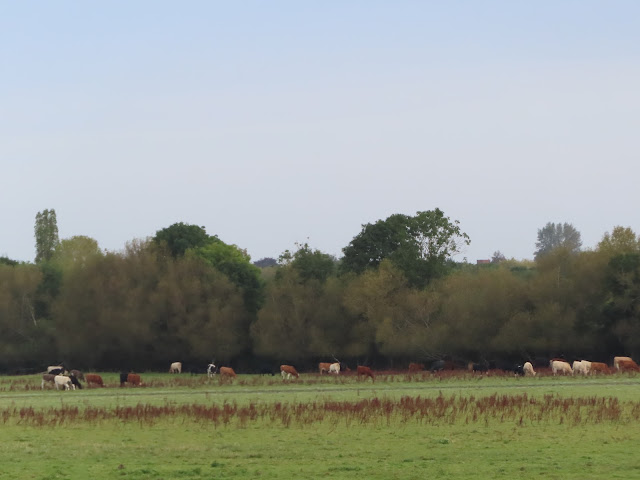 |
| It’s the first of many pastures on the menu today. |
 |
| An alternative approach to grazing? Or a metaphor for this country’s troubled relationship with the truth? |
 |
| Just up the road to the west is the tiny hamlet of Binsey. Once considerably larger, it is known for its St. Margaret’s Church’s legendary healing well, said to have been called up by Frideswide, Oxford’s patron saint. Long a pilgrimage site, it gained international fame when it inspired Lewis Carroll’s ‘treacle well’ in Alice’s Adventures in Wonderland. ‘Treacle’ was a medicinal term in the day of the Frideswide legend but by Carroll’s time had come to mean the syrupy by-products of sugar refining. |
 |
| Binsey also used to have a ford in this area, close to its still-active pub, The Perch. It was one of several farming villages that relied on and claimed rights to Port Meadow. |
The survival of any common,
especially one so large as Port Meadow, is of note in a country thoroughly
transformed by its violent Enclosure of them, from which process it has
inherited its present abusive land practices. It is tempting to attribute Port
Meadow’s survival to the power of the Oxford ‘freemen’ (i.e. that tiny minority
of its feudal population who were rich and male), into whose formal ownership
it had fallen by the time of the 1086 Domesday survey and under whose gaze the
peasant serfs of surrounding villages like Binsey, Medley and Wolvercote grazed
their animals here too.
Yet we should recall that with the
rise of Oxford University, the mere mortals of that city, even the privileged
officials among them, were not so powerful. In fact Port Meadow seems to have
become a perennial object of contestation between a thousand years of competing
interests. These included the ‘freemen’ and city authorities, the village
commoners, the Godstow nuns and the rising wool industry, as well as later industrial-age
comers such as the railway-builders, allotment-planters and flying clubs.
Far from a pastoral paradise, Port
Meadow must at times have been a merciless battle-pit for lawyers, bailiffs and
pitchfork-toting peasants as they had it out over rents, fines and licence
fees, fought off each other’s Enclosure claims, and seized each other’s horses,
geese and cattle. Ironically it seems to have been this perpetual struggle,
rather than any semblance of long-term cooperative project they could be
congratulated for, that guaranteed Port Meadow’s survival as a common. That is
to say, no invested party could make any permanent change to it without
incurring the prohibitively expensive wrath of everyone else.
 |
| The western bank seems less vicious by comparison. Perhaps the Mario and Luigi impression of this pair of trees has helped keep the peace. |
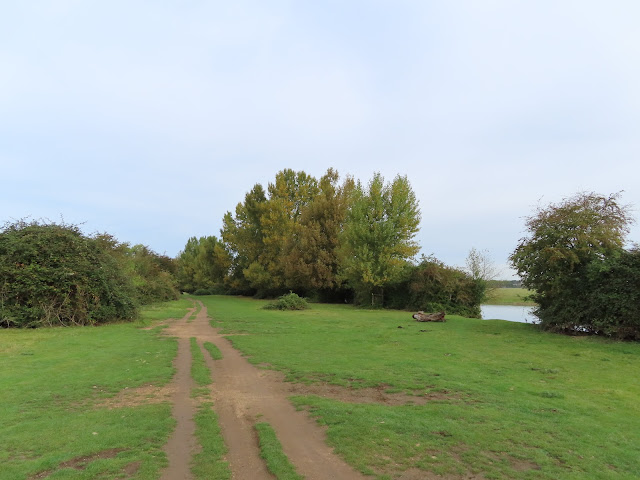 |
| Yet no patch of English soil is without a heritage of greedy violence it seems. The Binsey Poplars, a row of poplar trees, stood around here till they were summarily felled in the 1870s to feed the railway boom. Their destruction inspired a poem of lamentation by Gerald Manley Hopkins, and efforts to re-plant them have since drawn a great deal of management work to this bank. |
 |
| It also has its own bovine population. They graze right up to the river and will stand there exchanging remarks about you as you walk past. Show them lots of respect, especially if you see calves. |
Godstow
Near the top of the Port Meadow a
backwater arrives that was long drawn on by Wolvercote as a mill stream. At
this junction the main river flows through Godstow Lock, the first in
today’s sequence of upper-river locks and also the highest of all Thames locks
to use electro-hydraulic operation. In other words, if you’re travelling up
this way by boat, you have to physically open and shut all the locks from here
on (or hope there’s a nice lock-keeper on duty to do it for you).
 |
| If you know anyone in or near Oxford who recently lost their keys, let them know that they’re on this bit of wood somewhere in this random field near Port Meadow. |
 |
| The approach to Godstow Lock, with the Wolvercote Mill Stream curving away at right past the Hinksey Sculling School. |
 |
| Godstow Lock was built in 1790, replacing a flash weir, and rebuilt in 1924. |
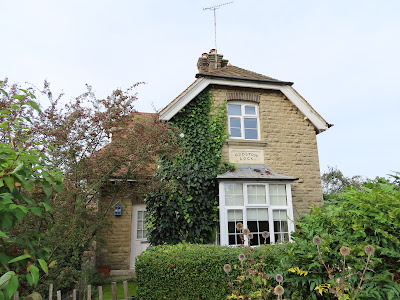 |
| The lock-keeper’s cottage. |
Through a gate at the far end of the
lock, this corner’s operative structure – or what’s left of it – sits
straightforwardly next to the river.
Godstow was an outlying participant in Oxford’s prospering medieval monastery
network. It was a nunnery – an all-female religious community – founded around
the 1130s by a woman called Ediva (a.k.a. Edith) from Winchester. The widow of
a Norman knight, the story goes that she followed visions in her dreams to
nearby Binsey. There instructed by the voices to find a light from the sky, she
saw a shaft of sunlight falling on this site, and so, with financial support
from king Henry I (always
keen to back such projects to build church support for his fragile Plantagenet dynasty), set up this Benedictine convent,
whose name means simply ‘God’s place’.
Clearly the place had clout and
profile, but perhaps because the English don’t like it when women have those
things, they took to attaching regular scandals to Godstow’s name in the
following centuries. Perhaps the most sensational concerned a certain
individual among the community (the extent of her membership as either nun or
student is unclear) whose name was Rosamund Clifford: a young noble from
the Welsh frontiers, best known as king Henry II’s favourite long-term lover.
The scandalism went on through to the
fifteenth century, by when Godstow seems to have swirled with stories of
dismayed inspectors, quarrelsome legal proceedings, extravagant lifestyles, and
the ever-recurring rumours of ‘ill-discipline’. Most of these seem to have
concerned the community’s contact with the secular outside world, especially
students coming up from Oxford. The hyperbolic tenor of some of these
reports leads one to think the nuns might as well have been abducting and
trapping them in their beds, when not overwhelming them with raucous drinking
and feasting. Perhaps the accusations really reflected the more
common story of powerful men in the church establishment resenting the idea of
a community of women making their own decisions, and so doing everything in
their power to hobble, constrain or otherwise interfere in the running of their
community.
There was less ambiguity about the
fall of Godstow, which took place, as at most other monasteries, in the late
1530s following sustained pressure from Thomas Cromwell and his commissioners
on behalf of Henry VIII. The last abbess, Katherine Bulkeley, surrendered the
nunnery after a principled stand in negotiations – and more caustically, a
personal stand against the official sent to receive that surrender, the Oxford
priest Dr. John London. Each accused the other of threats and assault, and in
the end the abbess secured a small victory in persuading Cromwell to remove Dr.
London so she could give up Godstow to a more amenable commissioner.
In a further familiar trend, the
final end to habitation in Godstow came in the Civil Wars. The house was
garrisoned by the Royalists to defend their Oxford headquarters, gunpowered and
occupied by the Parliamentary army, and its stones scavenged thereafter for
local building projects. What remains is now a scheduled monument under the protection
of Oxford University.
There is something almost
supernaturally daring about how Godstow’s ruins just sit by the river here,
with next to no protection or explanation in spite of the hostility it once
received or the hard-nosed interests still lurking nearby. Perhaps it’s
unsurprising then that the nunnery has gone on to lead quite an afterlife in
Oxford’s imagination. Both the ruins and The Trout inn featured heavily
in the lives of its literary heavyweights such as C. S. Lewis and J. R. R.
Tolkien; in that of Lewis Carroll before them, whose river trip that spawned Alice’s
Adventures in Wonderland is said to have come here; and also in the Inspector
Morse series of novels and TV dramas. One of Godstow’s most fully-defined
mythic outings, as well as one of its most recent, is in Philip Pullman’s
ongoing The Book of Dust trilogy, the sequel to His Dark Materials,
in whose parallel-universe Oxford the monastery with its industrious and
strong-willed nuns still exists (known there as the Priory of St. Rosamund –
now who might that be?); while The Trout, where one of the main
characters works, plays host to shady political intrigues prior to (what else?)
a great flood and darkly mythic river journey.
 |
| If not for Henry VIII there might have been teas and cakes on offer to walkers here today. He should feel bad about what he did. |
King’s Lock
Godstow is where the Oxford
conurbation ends. From here we’re into the hinterland. The casual pedestrians
and dog-walkers fall off, leaving the green swathes devoid of human presence
save for the occasional narrowboat or more committed hiker.
 |
| Just past Godstow is the 1961 bridge for the Oxford Ring Road, here part of the A34. In keeping with the otherworldly resonances of this place, it was given the breathtakingly imaginative name of Thames Bridge. The old City of Oxford boundary marker in the foreground indicates that travellers venture beyond at their own risk. |
 |
| A lost piece of either the agricultural revolution or World War I has fallen through a time-rift and landed under the bridge. |
 |
| Floofs. |
 |
| And from here on the river is basically like this. |
The river’s headwaters fall from the
west, but immediately above Oxford it swings into its first great loop which
constitutes most of this section. Looking west from here, you can see the
probable reason.
The heavily-wooded Wytham Hill
is the northwestern-most piece of raised ground in the central Oxford Plain,
and forms a part of that cluster which breaks the young river into a web of
marshy, flood-prone channels as it wrestles its way through. It circumvents
this limestone lump by circling north round its base, where those thick woods
come right up to the waterside.
After negotiating the hill, the river
arrives here at King’s Lock. This is the northernmost point in its entire
course.
 |
| The lock-keeper’s cottages begin to exhibit the colourations of Cotswold limestone. |
Wytham Foothills
If you were wondering which king this
lock was named for, it in fact has nothing to do with kings. The name comes
from Middle English kine, meaning cattle (as seen earlier in Wallingford’s kinecroft) – an animal whose ancestral
importance in this area, as reflected too in Ox-ford’s name, has not
entirely departed it yet.
 |
| West past King’s Lock – really the Cattle Lock, then – Wytham Hill slopes down to the river. |
 |
| The only settlement in the top of this bend is this farm compound. It appears to house the John Krebs Field Station, a research outpost of the Oxford University Department of Zoology. |
 |
| Even up here it’s still the Dark River. |
Before we can meet the true masters
of this terrain we must reckon with the Seacourt Stream. This is the
western-most of Oxford’s maze of channels, which leaves the main river here and
flows south, through the rustic village of Wytham, then Binsey with its
‘treacle well’. After that it joins the Bulstake and Hinksey streams.
Across the Seacourt Stream, a light
electric fence separates the field from the riverside. And in that field...
All these fields are flood-meadows
that spend a great deal of the year underwater. This poorly suits them to grow
crops, so instead they’re mostly used as grazing pastures with a herb-rich fare
much enjoyed by these fine fellows.
The fence keeps them in, but that
doesn’t stop them coming right up to the edge to inspect you.
It is important to show these the
proper respect. None of the cows on this section showed the slightest sign of
aggression, but occasionally – if, say, they’re protecting small calves, or surprised,
or provoked, or aggravated by the English political situation – they are known to attack passers-by and are quite capable of dealing serious injury or death if they feel so inclined.
Always observe how an individual or
group is behaving and avoid entering a field with them if you feel concerned. If
you do find yourself menacingly stalked, charged, or otherwise approached, it’s
generally advised to walk away calmly. Never run (they’re faster), or panic
(their charges are often warning bluffs that stop before they reach you).
Here another tributary river, the Evenlode,
arrives. Under that mysterious name it flows from the eastern Cotswolds in
Gloucester province, from where it passes the remnants of the equally
mysterious Wychwood, then the massive Blenheim Palace of Churchill fame, before
reaching the Thames here beneath Cassington.
 |
| The helpfully-labelled confluence with the Evenlode. It is virtually unnavigable and has had serious problems with sewage discharge and agricultural runoff. |
 |
| It’s plain from this range that the Wytham Woods are not messing around. |
This is where the woods of Wytham
Hill roll down to the riverbank. By all accounts this is no ordinary woodland.
Formerly part of the Abingdon Abbey estate, then held by the powerful
German-Jewish Schumacher family, by the time Wytham Great Wood was
bequeathed to Oxford University in the 1940s it still harboured an ancient and
extraordinary diversity of plant and animal life whose oldest sections are
thought to date back to the last ice age. Under the University it has since
become one of the most thoroughly-researched woodlands in the world, whose
yield of decades of copious data has been instrumental to ecological and
climate science.
 |
| From this side it presents something of a darkly forbidding air. The clouds of cawing ravens circling above its thick tree cover suggest strange rituals as old as some of the ecology in question. Apparently it’s very nice though. You can enter the main woods for free but need to apply for a permit from the University. |
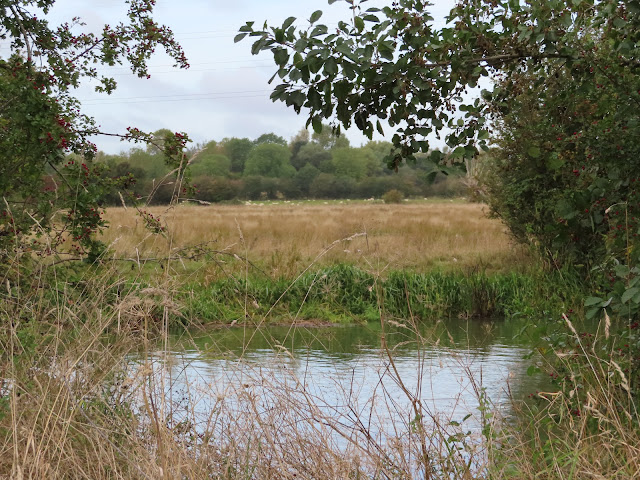 |
| Further pastures stretch away on the north bank. They’re not as isolated as they look; beyond those trees is the A40, the traditional trunk road between London and south Wales. |
A change of scenery follows as the
woods enswathe the riverbank.
 |
| Wytham Woods also feature in the Inspector Morse series as a convenient place to hide bodies. Watch where you walk in here. |
The woods open up toward the
northwest corner of the loop, where the river draws closest to the largest settlement
in this area: Eynsham. It’s set back about a kilometre from the river,
with access not helped by the busy B4044 road onto which the foliage which
overhangs its tiny pavement does its best to push you. A visit is therefore a
little out of contention given the distance still left to cover today, but Eynsham’s
link to the river is well-signified by its lock, pub, and bridge at its connected
hamlet of Swinford.
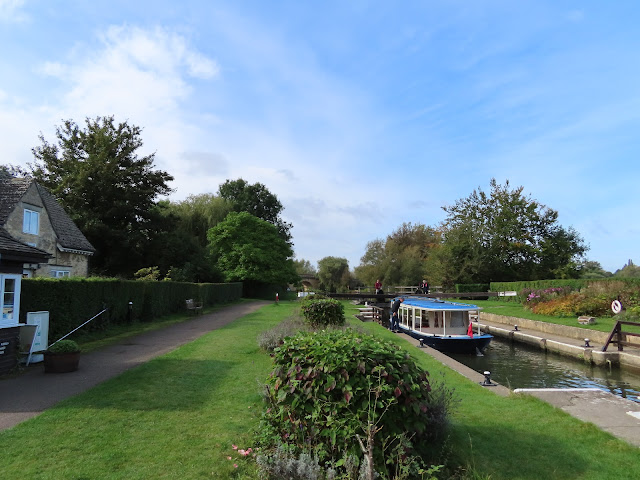 |
| Eynsham Lock was another latecomer, replacing more rudimentary weirs and flash locks in 1928. |
Eynsham is an ancient market village,
almost a town, with an astronomical-for-these-parts population of over 5,000. Said
to have emerged in Roman or sub-Roman times, it grew up in the Anglo-Saxon
period (whence its likely name origin, ‘Ægen’s enclosure’) owing to its
control of this important Swine-ford – i.e. a place where it was
relatively safe for pigs to cross amidst these unpredictable currents on the
Mercia-Wessex frontier.
Around 1005 Eynsham got its own
Benedictine abbey. It answered initially to Dorchester but flourished in its own right as
it grew over the centuries till its eventual demise – yet again – at the hands
of Henry VIII in 1538. This one was demolished quickly to stop the monks coming
back, and its ruins cannibalised to build new houses; many of its stones can
still be found in the village’s cottages today.
 |
| On the road between the river and village is The Talbot pub, one of a handful that serves walkers and boaters along these reaches. |
 |
| Swinford Bridge, a Georgian limestone construction from the 1770s. |
The Swine-ford itself seems to
have taken the form of a ferry for most of this period, but in the eighteenth
century this bridge was built to replace it. It is distinct in being the only
bridge besides Whitchurch Bridge to charge tolls to vehicle traffic
to this day (though pedestrians and cyclists cross for free since 1835). This
has apparently caused much contention: its private owners get to enjoy the
tax-free fleecing of local motorists, who often find themselves stuck in
congestion thanks to its toll queues and potholes. Attempts to get the 5p toll
abolished or bring the bridge into public ownership have so far come to
nothing.
 |
| Anyway, nice bridge. |
And with that we are clear of human
society and its instinct to casually oppress everything it touches, and now get
to proceed through some attractive landscapes down the west slopes of Wytham
Hill.
 |
| It can look pleasant out here. |
 |
| So here’s something to ruin it. The west bank here (opposite) falls under the parliamentary constituency of Witney, West Oxfordshire’s largest town. If the name sounds familiar it’s probably because it was the seat of David Cameron, the former Prime Minister and Conservative Party leader who set off the Brexit referendum for no reason, lost it, then walked off into the cover of his super-rich lifestyle to leave everyone else to eat the consequences. (On a related note, those pigs that crossed at Swinford – never mind.) |
 |
| It’s not these plants’ fault. They wouldn’t have plunged a country into an abuse-pit of division and disintegration while calling it democracy. |
 |
| Here we are. This is more like it. |
Now this time there’s no fence, and
the bovine community ranges hungrily right up to the river. Fortunately they’re
in peaceful if circumspective mood today, and will stand there watching you as
you cross their territory.
 |
| There’s no going around these ones. You’ll just have to hope they’re not inclined to demand tribute. Especially the chonky one at left. |
 |
| Wytham Hill is less wooded on this side and looks nice in the afternoon sun. Notice there’s another herd of Holsteins in the hillside field. |
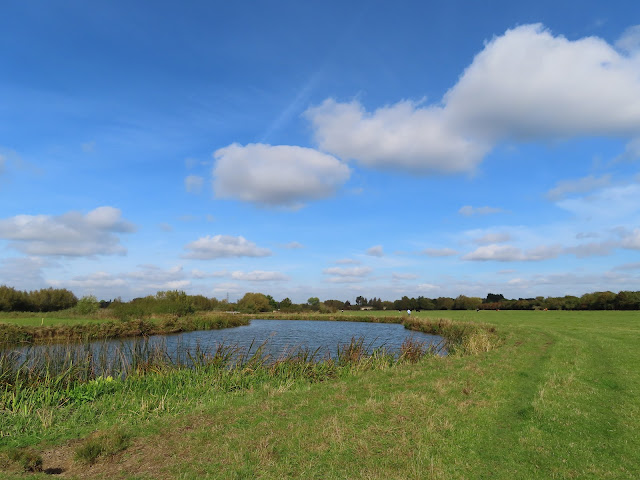 |
| The view back towards Swinford Bridge, with one or two other walkers negotiating their way through the sovereign herd. |
There’s another large boatyard ahead
here to help river-adventurers not get stranded after dark in the bovine
kingdoms. Oxford Cruisers Ltd. occupies a meander at the western end of the
village of Farmoor – a twentieth-century roadside settlement that takes
its name from an old common, now submerged beneath the reservoir ahead.
 |
| The skies here suffer the occasional rude intrusion of military aircraft, likely flying out of the major Brize Norton RAF airbase upriver. |
 |
| The family-run Oxford Cruisers appears to specialise in the repair and restoration of narrowboats. |
Here the wayfarer faces what at first
appears the unwelcome return of a menace that should have stayed behind on the
middle river: a string of residential properties which have seized the
riverbank for their private gardens, forcing an inland detour. Fortunately however
these ones appear forgivable. What actually seems to have happened is that their
claims did in fact stop at the towpath, only for it to crumble away over the
years due to erosion.
 |
| The detour is at any rate a short one, up the side of the Oxford-Eynsham road. |
Bablock Hythe and Northmoor
A trail between the houses leads back
to the towpath, which comes in short order to Pinkhill Lock. Built by
the Thames Navigation Commission in 1791 and named for a local farm, this one
is quite a bit older than those immediately downstream and cuts through the
neck of a large meander.
From here the towpath continues some
three kilometres down the east bank, past the Farmoor Reservoir, till it
reaches Bablock Hythe, where travellers and barge-workers historically crossed
by ferry. So why is it rumoured that the ferry no longer exists? To reach Bablock Hythe to examine this mystery, and furthermore to avoid
getting stuck on this side when the towpath switches bank, it is now necessary
to cross the lock-gates and take an extended detour through the western
pastures.
 |
| For a little further the river comes and goes as the path cuts across a string of wooded meanders. |
 |
| If you get a Game Over by being arrested and jailed by the cows then this is where you emerge when you re-load your last save. |
 |
| The western bank appears to fall under a rather woollier authority. |
This detour means we do not get a
view of the dominant landscape feature on this reach. Farmoor Reservoir,
the largest body of open water in Oxford Province, was dug out in two stages in
the 1960s and 70s and provides this region with its primary supply of drinking
water. It is also used for sports – fishing, sailing, windsurfing – and is very
popular with birdwatchers; its proximity to the Wytham Woods, along with other
local woodland and wetland reserves, draws in a wide range of seasonally-migrating
bird species.
 |
| Most of the islands and east-bank peninsulas in the meanders here are nature reserves with bird-watching hides installed. |
 |
| A distant glimpse of the Farmoor Reservoir embankment. |
Here we must seek the river’s pardon
in leaving it for a time, in order to circumvent the Bablock Hythe Caravan Park
which sprawls with grasping incorrectness up the riverbank ahead. The diversion
takes us into the sphere of influence of Stanton Harcourt – or
specifically, the fields after fields of sheep that together are many times
larger than the village itself.
 |
| Stanton Harcourt itself is a way up the road to the west here; this is the tower of its St. Michael’s Church. Stanton means ‘farmstead by the stones’, and likely refers to a nearby Neolithic stone circle now known as the Devil’s Quoits, sadly too far to reach on this journey. Harcourt is another ownership-tag on the part of the Norman nobility, added by the same family that later produced the Simon Harcourt who forced a whole village to move so he could build his riverside mansion. |
 |
| The village is too far to visit on foot if we want to safely complete today’s stretch before the sun goes down. So instead we get another bunch of pastures, this time with regular fleecy company. |
These fields are full of sheep. They
are a lot more skittish than the earlier cattle and tend to scoot away as soon
as they notice you coming, although a small minority will stand there
staring at you.
 |
| This individual is the lone exception, and will give you a neeh before taking tentative steps in your direction. |
 |
| They run off as soon as you touch the gate. It’s best to show them respect too, by treading gently and letting them know in a soft voice that you’re not here to make trouble for them. |
 |
| It’s chilly out here now, but still gets quite warm when the sun breaks through. Flexible clothing is sensible when walking in this season. |
Let’s have a closer look.
Make it across six or seven fields’
worth of sheep territory and you reach a tarmac lane: the main access road to
the river at Bablock Hythe.
 |
| The most visible manifestation of Bablock Hythe today is this sizeable caravan park. |
Bablock Hythe is a tiny hamlet,
composed mainly of The Ferryman Inn and now vastly overshadowed
by the holiday caravan park that’s taken up residence along its road and
riverside. This place’s importance was in its ferry, both practical and mythic (as of course all ferries are); all the more so for being some
thousand years old as well as supposedly the Thames’s first cable ferry,
drawn across the water along a large rope or chain.
So what happened to it?
In what seems a sadly typical
reflection of English modernity, after a millennium of service the ferry closed
down in hazy circumstances during the post-World War II decades. Efforts were
apparently made to revive it, with The Ferryman Inn running a new
passenger boat towards the close of the century, but that too has now vanished.
Some say it was washed ashore by floods and too damaged to resume service;
others suggest that someone stole it. Signs persist of strong local interest in
getting the ferry restored, but obtaining the funding to do so looks ever less
likely in the shadows of violent austerity and COVID-19.
Till they do so, the weighty whispers
of Bablock Hythe are left largely to a fading imagination. It’s an annoyance
for walkers, cyclists and local residents, who are forced to go all the way
down to Swinford or just as far up to Newbridge in order to cross. But perhaps
its real casualty is the centuries of cultural heritage invested in this site,
as another repository of Thames memories sinks into the mire of an age that
seems to regard such things as expendable.
 |
| The next meadow along appears to have been privatised by the caravan park for the leisure of its customers. |
 |
| They’re quite a long way out here, still reliant on instruments you’d usually have to go to a museum to see. |
Northmoor Meadows
The last four or so kilometres for
today cross the pastures of Northmoor, another tiny farming village
whose name means what it sounds (in reference to Southmoor on the other
side). These fields occupy this final corner of the great Wytham bend, beyond
which sits the historic Newbridge crossing.
 |
| Look who’s reappeared. |
 |
| It’s narrow enough to swim across now. Still, don’t underestimate it. You’d see its true character if the locks in these parts stopped working. |
 |
| Some thick woods known as the Eaton Plantation coat the east bank on the approach to the final curve. Eaton is a tiny hamlet beyond them whose manor has traditionally been held by Oxford’s St. John’s College, which used it as a refuge in times of plague. |
 |
| Possibly the wood’s tallest resident. |
These fields too are sheep pastures. These
ones’ inhabitants appear recently sheared.
 |
| These sheep look considerably more naked than their fellows in the fields downstream. |
 |
| The sun sets over Northmoor Lock after a long day of trekking through the pasturelands. |
Northmoor Lock was built in 1896 by the Thames
Conservancy, successor to the Thames Navigation Commission. One of the river’s
remotest locks of all, it is distinguished by its weir, thought to be one of
the last paddle-and-rymer weirs (requiring manual operation using paddles) in
the world. These are considered dangerous under present-day legislation, with
most surviving examples on the Thames removed in recent years.
 |
| Northmoor Lock. It was here that the crew of ‘Tug No.2’ finally realised with great mirth that we’d been inadvertently following each other all day. |
 |
| The lock-keeper’s cottage, largely unchanged since it was built. |
On the final stretch a short sequence
of residences take their late-day revenge with private-property claims to the
riverbank opposite. But they’re considerably humbler than those we put up with
in the middle river, and wisely do nothing to obstruct this final progress up
the north side.
 |
| The typical character of the last length of river to Newbridge. |
 |
| Less unaffordably ostentatious mansion, more holiday cottage, one might think. |
 |
| The most showy of those houses... |
 |
| ...and its boathouse, whose slanted posture suggests it’s trying to exist in mismatching timelines simultaneously. |
And at last, the fences and thickets
close in on the approach to a key strategic crossing.
 |
| Look at that. Just when we’d thought they’d stopped. Newbridge is strategic, yes, but steady on. |
 |
| The New Bridge appears, by whose pubs the river-travellers have pulled in their boats for the night. |
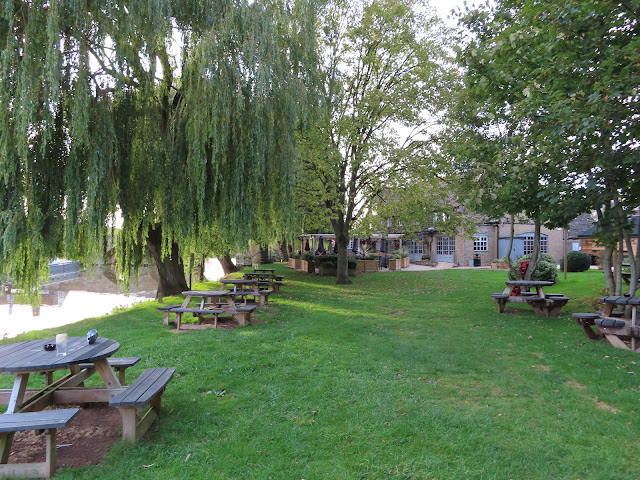 |
| The final approach passes through the gardens of The Rose Revived, one of the two pubs that face each other across the bridge. |
Newbridge
This doesn’t really qualify as a
settlement. Newbridge is literally a bridge with a pub at each end – The
Rose Revived on the north side, The Maybush on the south – standing
together out in the open countryside. That said, it’s a hearty sight at the end
of eight hours’ slogging through said countryside, and does moreover hold a few
features of great significance.
The most obvious is the bridge
itself. Despite its name, the New Bridge, which carries the A415
Abingdon-Witney road, is the oldest surviving bridge on the Thames. (It
competes for this status with Radcot Bridge upriver, which pre-dates it but got
wrecked in multiple conflicts and required extensive rebuilding). This bridge
has stood continuously since the early thirteenth century, when it is thought
to have been one of a set of bridges in this area built by
Norman monks on the
orders of King John. The likely context was the growth
of the Cotswold wool trade at that time, with its rising demand for access to
southern markets.
For all its isolation, Newbridge sits
at a strategically important location equidistant from the urban nuclei of
Oxford, Abingdon and Witney. This got it threatened during the Civil Wars, in
particular in 1644 when the Parliamentary army got into a skirmish with
Royalist defenders as they attempted to cross to encircle the king’s Oxford
headquarters. They did not succeed – it was too soon – and it was this,
supposedly, that put them in such a bad mood as to take it out on Abingdon’s market
cross as they retreated there.
The bridge itself survived however,
and has continued to do so through all the trials of industrialisation, the car
and road revolution, and the contempt for heritage of a market fundamentalist
age. It has perhaps come closest to trouble in the last couple of decades as
its eight-hundred-year-old arches and elm-beam foundations noticeably struggle
to cope with present-day traffic loads, regulated as they are by traffic lights
and an eighteen-tonne weight limit. A new (that is, Newer) bridge close by
looks the likeliest of answers, yet for the moment local opposition and a lack
of funds seem to have put the matter on hold.
Why here then? What was the
underlying significance of this site? As always it is the water that must have
the final word, and that word is one which as of now should send caterpillars
of shame down every English spine.
The tranquil Windrush, with a
name thought to come from the ancient Celtic for ‘white fen’, rises in the East
Gloucestershire Cotswolds and glides a gentle path down through West
Oxfordshire, via Witney, to arrive at the Thames here. It is up this waterway
that stands the famed ancient quarries of Taynton, whose Cotswold limestone it
brought forth to build this New Bridge as well as the grandiose
dreamscape of the Oxford colleges.
Yet the Windrush is best known for
another signature it left in this country’s history. After the German cruise
ship MV Monte Rosa was repurposed as a transport and prison ship by the
Nazis, it was seized by the British in northern Germany in the closing months
of World War II. Following the pattern of giving captured ships the names of
rivers, it was this here tributary that rebirthed that vessel under the new
name of HMT Empire Windrush. Three years later, in 1948, it would
sail into Tilbury harbour on its most famous journey: that which brought
several hundred migrants from the then-British colony of Jamaica, who along
with other colonial ‘subjects’ had all just been granted British citizenship. Many were responding to British adverts in Jamaican newspapers to
come and work in the ‘mother country’ as it staggered from the bombed-out
wreckage of the war.
These passengers were the first in a
generation of Caribbean immigrants who took up the call to come here, helped this country rebuild, made critical contributions from public transport
to the fledgling National Health Service (NHS) in a time of labour shortage,
and together with those who arrived after them earned an esteemed place in
national memory under the name of the ship on which they first arrived, and by
extension the river for which it was named: the Windrush Generation.
But of course, everyone knows the hellish
descent of this story. These people received racist hostility from the start,
not least from a government whose extension of citizenship to the colonies had
been aimed at light-skinned people from, say, Canada or Australia – and who
when they realised also included dark-skinned people, turned heaven and earth
upside down to stop more coming. Decades of violence, prejudice and
discrimination followed, much of it orchestrated by racist (when not explicitly
neo-fascist) politicians and popular movements. And in the 2010s their successors
in the Conservative Party government completed a horrific revenge by illegally
deporting hundreds of citizens from the Windrush Generation, many of whom had
lived and worked in this country for almost their entire lives, as part of the Hostile
Environment programme of racial persecution.
This Windrush Scandal, as it
became known, only broke in 2017 after committed efforts by investigative
journalists to expose it. It temporarily unbalanced the government, most
notably forcing the resignation of Home Secretary Amber Rudd. But the damage
was done: huge numbers of Windrush citizens had had their lives destroyed, losing their jobs, homes, communities, loved
ones, physical and mental health, and in some cases dying in trauma without
ever receiving redress. Since then the scandal has largely been overtaken in
the news by disasters like Brexit and COVID-19, with the result that its
victims continue to suffer the consequences unaided by a risibly ineffective
compensation scheme. Moreover, no-one has been criminally charged for the
cruelties inflicted upon them, and far from being discouraged, the wanton
forced deportations continue to worsen, with total impunity, upon a surging
tide of government-led culture-war-infused popular xenophobia.
Fitting then that the Windrush river
is where we end this day’s journey. Lest the broad expanse of green and blue lead
us to believe we can ever escape this country’s descent, we are
washed back to reality by this river of tears, which laments into the Thames
the atrocities committed unto its name.















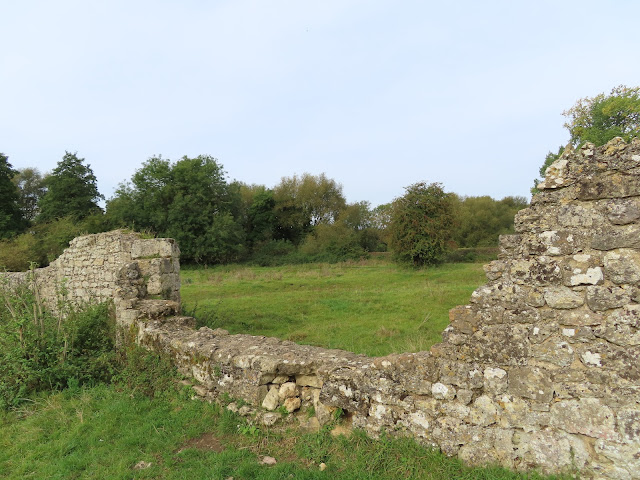






















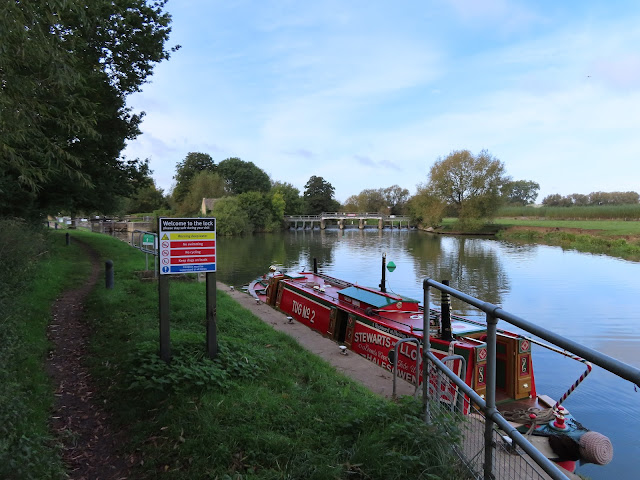


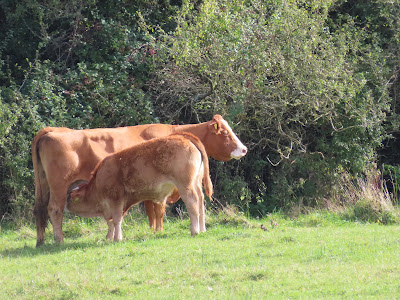




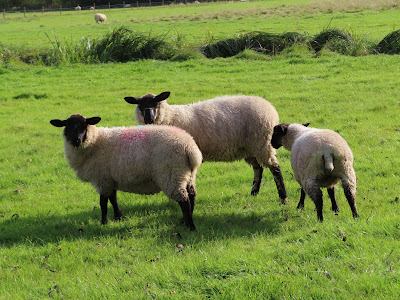


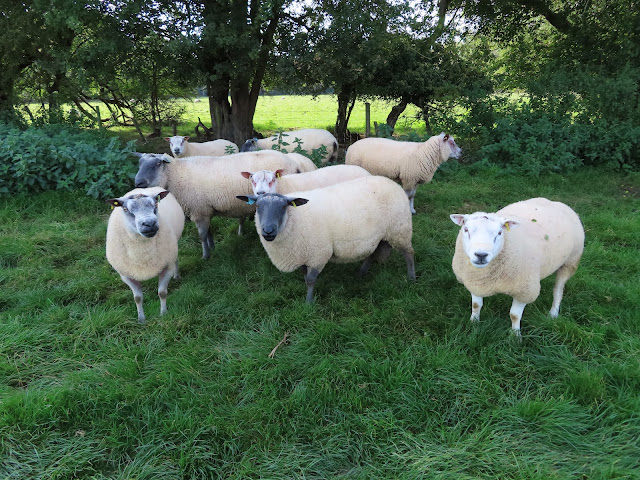







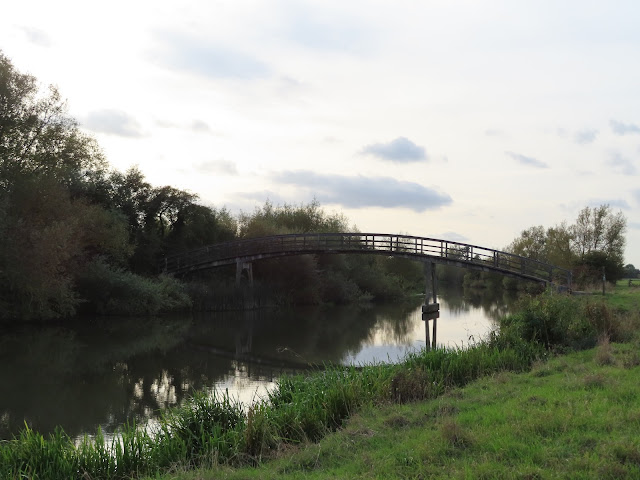






No comments:
Post a Comment